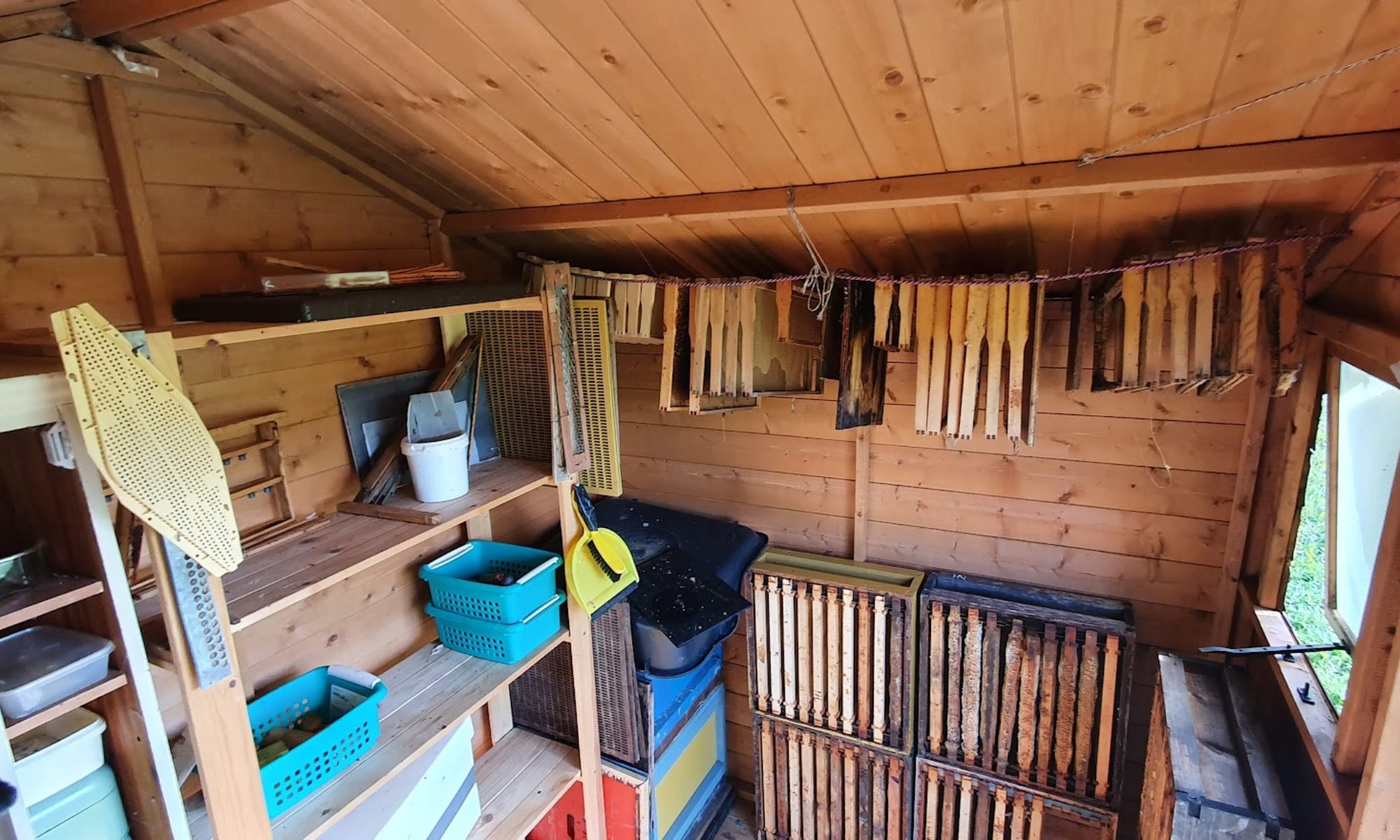Yesterday morning I got a call just as I got to work. “There is a swarm, 12ft up a tree, next to your hives”. Well it had to stay there for the day, I had only just got to work and I commute 90 mins each way. On Tuesday, 2 days before I’d been an caught a swarm, and put it in a super on top of the hive because I’d run out of equipment, then the day before I’d been finding queens and had noticed that the swarm had left. I had a good look around and had not seen where it had gone to, so I figured it had found a new home; meanwhile crossing my fingers that it had found a hollow tree or similar and not someone’s roof space. I had not looked straight up. I figured with that history that it must be that swarm.
After work I headed for the apiary, and there it was 12ft up and about 10ft to the right of the super where I had put the swarm 2 days before. Fortunately I was supplied with some scaffolding to wheel into place under the hive, far safer than trying to use a ladder I’m sure. I got my collecting skep and went up. I only just managed to reach the branch on my tip toes, and held the skep under the swarm. I pulled sharply down on the branch and … fudumph… 80% of the bees went straight in the skep. This was ‘not’ the swarm from the other day, it was far larger, and far heavier, twice as much if not more.
I got down and prepared the nuc I had brought. The boot of my car is like a travelling bee equipment emporium these days. I poured the bees in, and there were too many. Luckily I had closed up the entrance or they would be pouring straight out the front. I was putting the frames back in and they were sat high on top of the huge mound of bees in the bottom; and I hadn’t even collected all the bees yet. There were a fair few bees flying about and still a clump on the branch, which had risen out of my reach when it was relieved of this mighty clump of bees I’d already retrieved. To cut a long story short I got the bees and closed them up and put them in the boot of the car.
I checked through all the hives and with the exception of one that was small before anyway they were all full of bees, so where had the swarm come from, especially if it was not the swarm from the day before, because it was much larger.
But, as usual with my bee adventures that was not where the fun ended… There was another swarm, this one hanging under the hive that had swarmed two days before. Now trying to get a swarm out from under a hive, that’s ‘fun’. Oh, hang on, no its not. I was brushing them off and trying to get what I could in the skep, and dropping them on the floor on a sheet and brushing them off that into the skep. Then I was smoking them, so that if, per chance, I had already got the queen in the skep, I would maybe be able to hide the queen scent left behind. If I hadn’t got the queen in the skep, maybe she would move out of such an inaccessible area, and hang on a tree, like Tuesday’s swarm when I smoked the grass and weeds it was sat in on the fence.
After far too long, I was pretty much giving up trying to get them out, they kept dropping on the floor and running back up the leg. Then I noticed that they had started making little spots of wax. Well I know that swarms do do that, but this was on the underside of the mesh floor of the hive. In nature, bees start at the top of a cavity and build downwards; maybe that’s what these were up to. Maybe it was far fetched, but maybe not.
I’d had enough for the evening. I didn’t know if I’d got the queen or even if it really was a swarm. I put the skep on a hive floor a few feet away (on a step stool, not on the floor), propped up so the bees could get in and out. I figured:
- If it was not a swarm the bees would wander back to the hive when they got bored…
- If it was a swarm and I’d caught the queen and got her in the skep, they would find her in there and stay there
- If it was a swarm and I had not go the queen, well… I guess they would just have to fend for themselves.
I took the large swarm in the back of the car to the other apiary and put them in a national hive, but I also put a queen excluder between the brood box and the floor so they would not swarm because the queen can’t get out. That’s what I’m told the theory is anyway.
Its now the next night, I’ve not been back to the apiary to check the skep and not been to the other to remove the queen excluder. Three days in a row is enough, especially as I’m doing all this writing up now, and I’ll have to go over the weekend anyway, and I need to build more commercial brood boxes to home everyone…

